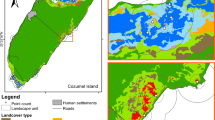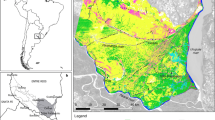Abstract
Despite making up 20–60% of the North American boreal landscape, wetlands and their associated bird communities remain poorly understood. In the context of forest management and avian conservation, wetland classification presents an opportunity to classify and investigate wetland bird communities. We compared bird communities among a suite of eight wetland classes in the southern Boreal Plains ecozone of Manitoba and tested whether wetland classification was a useful tool for delineating habitat for birds. To provide context for how wetlands fit into a managed forest setting, we compared wetland classes with structurally similar harvested deciduous and mixedwood stands early in succession (5–7 years) to assess potential overlap in community composition. We conducted fixed-radius (100 m) point counts across 83 sites and used a combination of multivariate techniques to determine whether individual wetland classes supported characteristic bird assemblages and species. Our study suggests using established approaches to classifying wetlands will be helpful for documenting the full breadth of habitats used by boreal birds. Given ongoing industrial development, particularly in the boreal plains ecozone, further research is needed to determine effects of human disturbance and support the conservation of a full spectrum of wetland classes in the boreal landscape.


Similar content being viewed by others
References
Brook RW, Clark RG (2005) Breeding season survival of female lesser scaup in the northern boreal forest. Arctic 58:16–20
Calmé S, Desrochers A (1999) Nested bird and micro-habitat assemblages in a peatland archipelago. Oecologia 118:361–370
Calmé S, Desrochers A, Savard J-PL (2002) Regional significance of peatlands for avifaunal diversity in southern Quebec. Biological Conservation 107:273–281
Clare S, Krogman N, Foote L, Lemphers N (2011) Where is the avoidance in the implementation of wetland law and policy? Wetlands Ecology and Management 19:165–182
Clarke KR (1993) Non-parametric multivariate analyses of changes in community structure. Australian Journal of Ecology 18:117–143
Conway CJ (2002) Standardized North American marsh bird monitoring protocols. 1–23
Cowardin LM, Carter V, Golet FC, LaRoe ET (1979) Classification of wetlands and deepwater habitats of the United States. U.S. Department of the Interior, Fish and Wildlife Service, Washington
Darveau M, Beauchesne P, Bélanger L, Huot J, Larue P (1995) Riparian forest strips as habitat for breeding birds in boreal forest. Journal of Wildlife Management 59:67–77
Dufrêne M, Legendre P (1997) Species assemblages and indicator species: a need for flexible asymmetrical approach. Ecological Monographs 67:345–366
Environment Canada (2004) Threats to water availability in Canada. National Water Research Institute, Burlington
Erskine AJ (1977) Birds in Boreal Canada: communities, densities, and adaptations. Canadian Wildlife Service Report Series Number 41. Ottawa, Ontario
Fast PLF, Clark RG, Brook RW, Hines JE (2004) Patterns of wetland use by brood-rearing Lesser Scaup in northern boreal forest of Canada. Waterbirds 27:177–182
Foote L, Krogman N (2006) Wetlands in Canada’s western boreal forest: agents of change. The Forestry Chronicle 82:825–833
Fox AD, Bell MC (1994) Breeding bird communities and environmental variable correlates of Scottish peatland wetlands. Hydrobiologia 279(280):297–307
Hågvar S, Nygaard P, Bækken BT (2004) Retention of forest strips for bird-life adjacent to water and bogs in Norway: effect of different widths and habitat variables. Scandinavian Journal of Forest Research 19:452–465
Hanowski J, Danz N, Lind J, Niemi G (2003) Breeding bird response to riparian forest harvest and harvest equipment. Forest Ecology and Management 174:315–328
Hanowski J, Danz N, Lind J (2006) Response of breeding bird communities to forest harvest around seasonal ponds in northern forests, USA. Forest Ecology and Management 229:63–72
Harris AG, McMurray SC, Uhlig PWC, Jeglum JK, Foster RF, Racey GD (1996) Field guide to the wetland ecosystem classification for northwestern Ontario. Ontario Ministry of Natural Resources, Northwest Science and Technology, No. NWST Field Guide FG-01, Thunder Bay, Ontario
Hobson KA, Bayne EM, Van Wilgenburg SL (2002) Large-scale conversion of forest to agriculture in the boreal plains of Saskatchewan. Conservation Biology 16:1530–1541
James FC (1971) Ordinations of habitat relationships among breeding birds. Wilson Bulletin 83:215–236
Kardynal KJ, Hobson KA, Van Wilgenburg SL, Morissette JL (2009) Moving riparian management guidelines towards a natural disturbance model: an example using boreal riparian and shoreline forest bird communities. Forest Ecology and Management 257:54–65
Kardynal KJ, Morissette JL, Van Wilgenburg SL, Bayne EM, Hobson KA (2011) Avian responses to experimental harvest in southern boreal mixedwood shoreline forests: implications for riparian buffer management. Canadian Journal of Forest Research 41:2375–2388
Kirk DA, Diamond AW, Hobson KA, Smith AR (1996) Breeding bird communities of the western and northern Canadian boreal forest: relationship to forest type. Canadian Journal of Zoology 74:1749–1770
Legendre P, Legendre L (2002) Numerical ecology. Elsevier, Amsterdam
Locky DA (2005) Boreal plains peatlands: characterization, plant diversity, biogeography, and impacts from logging. Doctoral Thesis University of Alberta (Canada)
McCune B, Grace JB (2002) Analysis of ecological communities. MjM Sofware Design, Gleneden Beach
Mitsch WJ, Gosselink JG (1993) Wetlands. Van Nostrand Reinhold, New York
National Council for Air Stream Improvement (2007) Synthesis of technical information on forest wetlands in Canada. National Council for Air and Stream Improvement, Inc.,No. Technical Bulletin No. 938, Research Triangle Park, N.C.
National Wetlands Working Group (NWWG) (1997) The Canadian wetland classification system. Canada Committee on Ecological Land Classification, Environment Canada
Nichols JD, Hines JE, Sauer JR, Fallon FW, Fallon JE, Heglund PJ (2000) A double-observer approach for estimating detection probability and abundance from point counts. The Auk 117: 393–408
Paszkowski CA, Tonn WM (2000) Community concordance between the fish and aquatic birds of lakes in northern Alberta, Canada: the relative importance of environmental and biotic factors. Freshwater Biology 43:421–437
Quinn GP, Keough MJ (2002) Experimental design and data analysis for biologists. Cambridge University Press, Cambridge
Ralph CJ, Sauer JR, Droege S (1995) Monitoring Bird Populations by Point Counts. Pacific Southwest Research Station, Forest Service, U.S. Department of Agriculture, No. General Technical Report. PSW-GTR-149., Albany, CA
Rempel RS, Abraham KF, Gadawski TR, Gabor S, Ross RK (1997) A simple wetland habitat classification for boreal forest waterfowl. Journal of Wildlife Management 61:746–757
Riffell S, Burton T, Murphy M (2006) Birds in depressional forested wetlands: area and habitat requirements and model uncertainty. Wetlands 26:107–118
Schieck J, Hobson KA (2000) Bird communities associated with live residual tree patches within cut blocks and burned habitat in mixedwood boreal forests. Canadian Journal of Forest Research 30:1281–1295
Schulte LA, Niemi GJ (1998) Bird communities of early successional burned and logged forest. Journal of Wildlife Management 62:1418–1429
Smith KG (1977) Distribution of summer birds along a forest moisture gradient in an Ozark watershed. Ecology 58:810–819
Smith KB, Smith CE, Forest SF, Richard AJ (2007) A field guide to the wetlands of the boreal plains ecozone of Canada. Ducks Unlimited Canada, Edmonton
Swift BL, Larson JS, DeGraaf RM (1984) Relationship of breeding bird density and diversity to habitat variables in forested wetlands. The Wilson Bulletin 96:48–59
Virkkala R, Luoto M, Heikkinen RK, Leikola N (2005) Distribution patterns of boreal marshland birds: modelling the relationships to land cover and climate. Journal of Biogeography 32:1957–1970
Welsh DA, Lougheed SC (1996) Relationships of bird community structure and species distributions of two environmental gradients in the northern boreal forest. Ecography 19:194–208
Wilson WH Jr. (1996) The birds of North America: palm warbler (Dendroica palmarum). The Academy of Natural Sciences; The American Ornithologist’s Union. Philadelphia; Washington D.C.
Acknowledgments
The authors would like to acknowledge Environment Canada, Louisiana Pacific- Swan Valley Division, Ducks Unlimited Canada, Sustainable Forest Management Network, Manitoba Conservation for funding and logistical support. D. Kopecky, V. Bauman, T. Lanson, M. Robin, and K. Smith provided field and technical support. We also thank T. Cobb, K. Smith and 2 anonymous reviewers for helpful comments on earlier drafts.
Author information
Authors and Affiliations
Corresponding author
Appendix A
Appendix A
Rights and permissions
About this article
Cite this article
Morissette, J.L., Kardynal, K.J., Bayne, E.M. et al. Comparing Bird Community Composition Among Boreal Wetlands: Is Wetland Classification a Missing Piece of the Habitat Puzzle?. Wetlands 33, 653–665 (2013). https://doi.org/10.1007/s13157-013-0421-1
Received:
Accepted:
Published:
Issue Date:
DOI: https://doi.org/10.1007/s13157-013-0421-1




